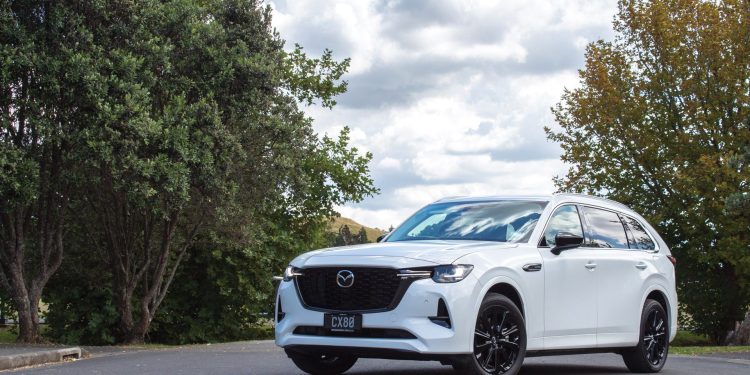2025 Mazda CX-80 SP Hybrid Review
Words: Kyle Cassidy | Photos: KC
The CX-80 joins the Mazda ranks as another seven-seat option for buyers of large SUVs. How is it different to the three-row CX-90 though?
Mazda has bulked up its large SUV offerings with the CX-80. It’s another three-row crossover, but one that is slightly more affordable than the range-topping CX-90 (which is also a seven seater). Think of this as a stretched CX-60, being longer in the wheelbase, with more room in the rear. It’s also a bit more ‘right-sized’ for NZ. Where the CX-90 is 5.1m long and 2m wide, the 80 is slightly less gargantuan at 4.99m and 1.9m wide. It sits on the same length wheelbase, so the interior space is still decent. This is touted by Mazda NZ as being more of a true replacement for the CX-9 in terms of size and price.
How much and how many?
There are three CX-80s to pick from, starting at $74,990 for what they call the SP Hybrid e-SKYACTIV G 3.3. What a mouthful. SP 3.3 rolls off the tongue more easily. Then there’s the SP with Mazda’s 2.5 plug-in powertrain going for $80,990 and the over-spec’d Homura Plug-in is $89,490. That’s not far off the $92k asked for the CX-90 3.3.
Some of the items in the SP include leather seat trim with powered and heated front pews, blacked out 20s and other exterior details, LED lights, power tailgate, a 360 degree camera and a smart key. Perhaps not so smart however are the proportions of the CX-80. In profile, it looks slab-sided, especially when seen next to the more sculptured CX-90.
What’s under that long bonnet?
Those opting for the plug-in get the promise of 59km of EV driving on a full charge (probably less in ‘real world’ situations) thanks to a 17.8kWh battery. This powers a 129kW/270Nm motor that can combine with the 2.5-litre four cylinder to make a total system output of 241kW and 500Nm. You’ll likely never get close to the claimed 1.7L/100km consumption figure, unless you only ever drive 60km or so everyday, and recharge nightly. And with a $6k premium and RUCs to pay, the 3.3 is probably the better bet. And it can drink 91, whereas the plug-in requires 95.
The turbocharged 3.3 is a hybrid of the mild kind, getting a 48v device to help trim fuel use by turning off the engine when it gets the chance and also adding a small boost at low speeds. The WLTP fuel use figure is 8.4L/100km while it makes 209kW and 450Nm of easy, creamy torque. That’s not quite as hefty a punch as CX-90 owners enjoy however; they get a 254kW/500Nm tune of the 3.3.
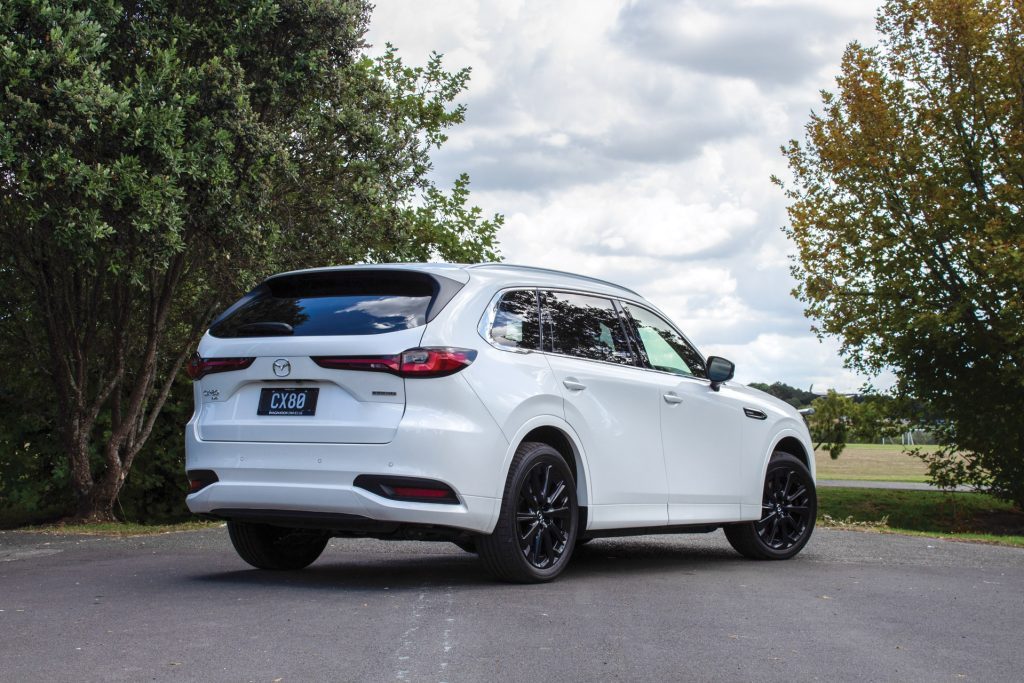
Go okay though?
The six is lovely and smooth, the mechanical torque helped by some mild electrification. Along with more seamless restarting and a bit of a boost off the mark, the engine will occasionally switch off under light throttle loads and when coasting. While 8.4L/100km is the claim, somewhere in the 10s is more likely if you manage to mix some motorway running with stop/start urban driving (which can see the average slip into the 12s if you’re rushing about).
The eight-speed auto is generally smooth, though it does dish out the odd clunky shift now and again when grinding through stop start traffic. The first to second shift can be a little sharp too. It’s not bad but it’s just that other hybrid powertrains in large SUVs are more refined in this regard.
The steering has some reasonable heft at city speeds compared with other large SUVs too. It could be quicker as well, requiring less effort to manoeuvre about the cityscape. Its turning circle is on a par with other big wagons, and the ride quality here is well sorted.
The active safety features, like the lane keeping assistant, try to keep themselves in the background. An interior spy will snitch on a distracted driver occasionally, but usually only when you are looking away, trying to work out which way to twirl the knob for the infotainment system. There’s no overspeed warning, the speed recognition system displaying the limit on the dash, which will flash discreetly when you dare go over. The one irksome feature; the CX-80 likes to give you a warning when you’re at an intersection or leaving a driveway, alerting you to oncoming traffic. Its adaptive cruise gets the traffic busting stop and go function.
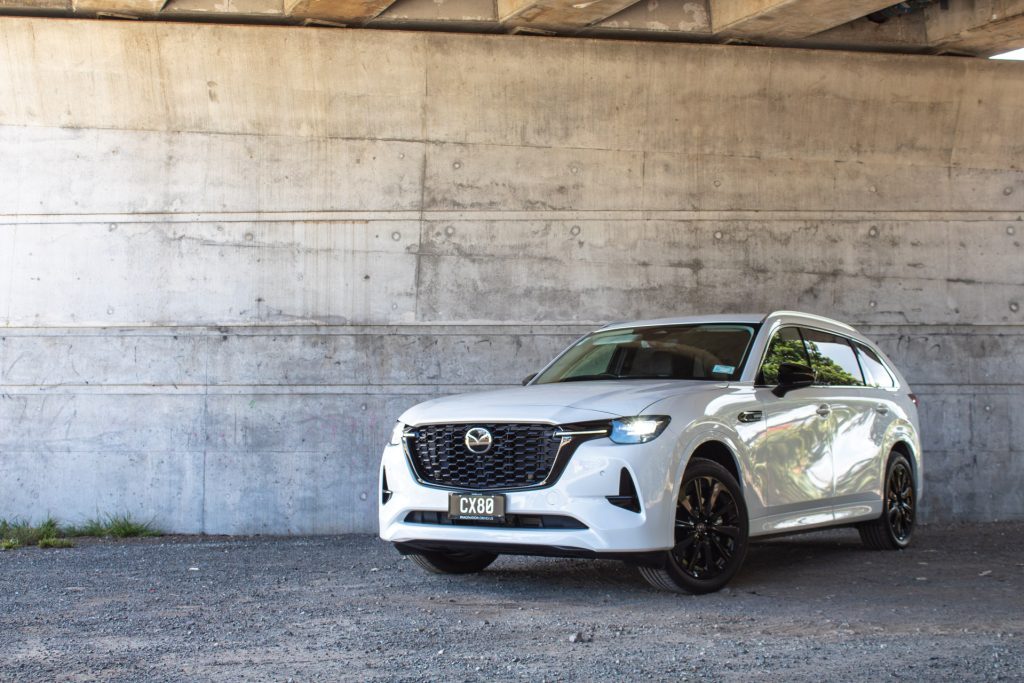
Jinba Ittai here too
The CX-80 is the Japanese version of the X5 when it comes to devouring twisty roads. The steering that feels just a little heavy in the city gels much better as speeds increase. That weighting is just right here, the helm directing the front wheels accurately and delivering a dose of feedback too. The CX-80 may be large and fairly hefty, but the mass feels evenly split, which helps deliver a controlled and balanced behaviour in the curves. This is helped by the all-wheel drive system having a rearward torque bias. And so powering on out of the bends, it doesn’t overstress the front tyres, which are largely left to do the steering. Adaptive dampers aren’t a feature, but aren’t missed either. The CX-80’s suspension is good at smoothing over the bumps; the ride remains reasonably settled over most road surfaces, and yet the roll is well contained. The brakes have a good feel about them too, rounding out a competent dynamic package.
The engine is all about the mid-range and it gets along just fine without needing to switch into Sport. But should you do so, you’ll find the transmission holds each ratio a little longer. However, it’s not too racy. Stomp on the gas and the six winds out to just over 6000rpm and it sounds okay too, in a muted, understated fashion. Driven in a more family-friendly manner, the transmission does a good job of keeping an eye on the fuel economy, usually setting the six to below 2000rpm whenever possible, though it’s quick to kick down when an overtake is required.
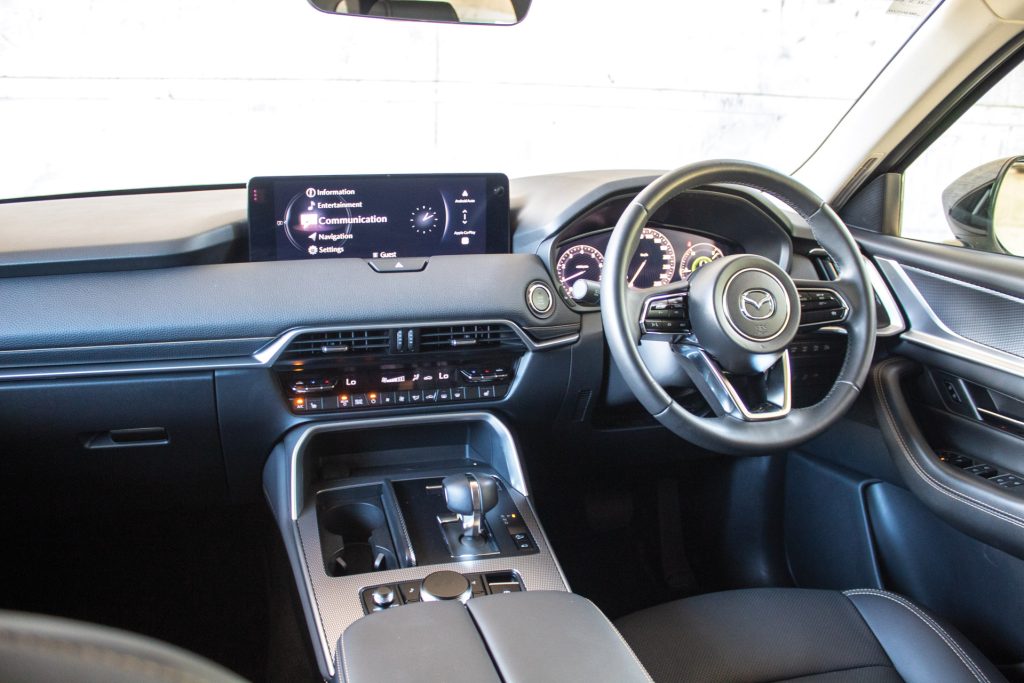
Flash enough for the cash?
You’ll like the cabin quality; this is well made with premium materials. The seat has plenty of adjustment and fits just right. General storage is a little lacking, especially on the centre console where the gear lever and infotainment controller take up much of the available space. The cup holders do the job, and there is a phone charger.
A 12.3-inch screen sounds big enough, but it’s a wide format, lacking depth. And it’s controlled largely via the twirly knob on the centre console (even BMW has finally admitted defeat on those). That’s not so bad as it’s not the interior overlord (separate buttons for the ventilation, for instance) and it offers wireless Apple CarPlay and Android Auto, both with a more vibrant interface than Mazda’s monochromatic theme.
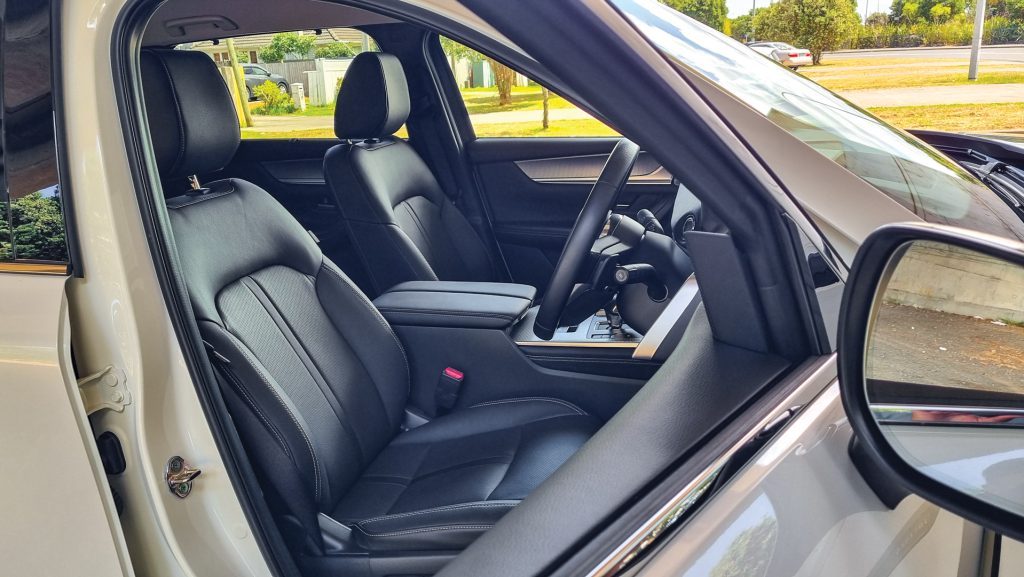
Practical too?
At the business end, the second row affords enough space for three kids comfortably, a trio of adults at a squeeze. There are a couple of USB ports and rear seat ventilation controls. It has the usual versatile seat functionality of a three-row SUV; sliding forward when those in the back need some space, folding down flat when you’ve got something big to haul, and tilting out of the way (via a tricky ‘one-touch’ mechanism here) when the kids want to clamber into the back seats. This is made easier by the big, wide opening rear door, though these may pose an issue in tight car parks.
The third row is easy enough to manipulate, and when they are tucked away, the CX-80 has a good-sized hold, complete with handy three-pin power socket. Aiding its versatility, the CX-80 has a 2500kg braked tow rating (150kg download rating), which applies to the plug-in too.
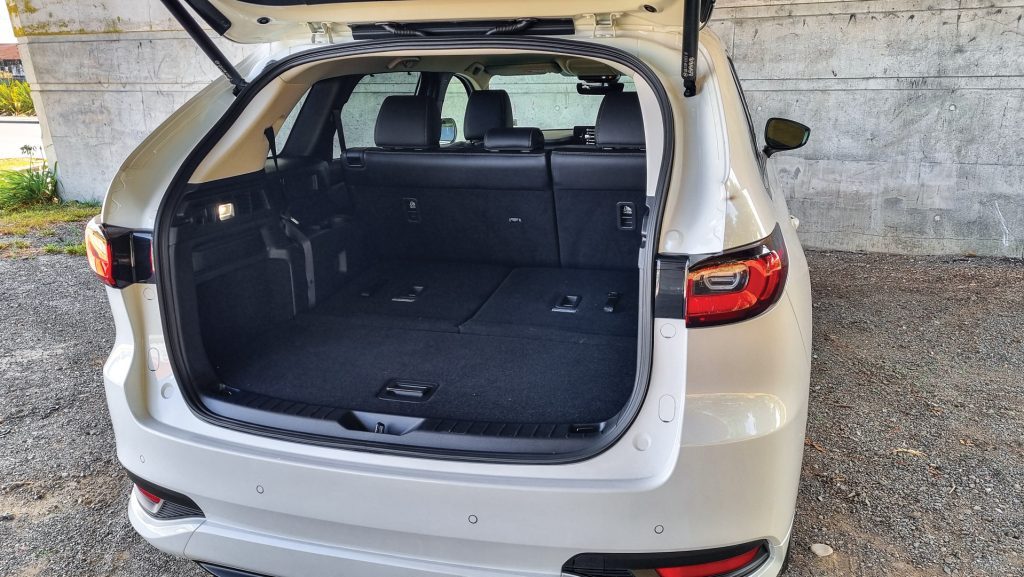
Worthy then?
Being a lot more affordable than the CX-90 sure helps the CX-80 3.3’s case. And so this Mazda seven-seater stacks up better against the competition, which all seem to be in and around that $75k mark. The 3.3 drives well, but is thirsty compared with high voltage hybrids in the segment (Sorento, Highlander, Santa Fe). Still, it’s a functional seven-seater and its tow rating might appeal as well. As might the warranty and after sales service package.
Mazda CX-80 SP hybrid
$74,990 / 8.4L/100km / 189g/km
0-100 km/h 7.23s
80-120 km/h 4.25s (120m)
100-0 km/h 36.89m
Speedo error 98 at an indicated 100km/h
Ambient cabin noise 71.2dB@100km/h
Engine 3283cc / IL6 / T / DI
Max power 209kW@5000-6000rpm
Max torque 450Nm@2000-3500rpm
Drivetrain 8-speed auto / on-demand AWD
Front suspension Wishbones / swaybar
Rear suspension Multilink / swaybar
Turning circle 11.6m (2.7 turns)
Front brakes Ventilated discs
Rear brakes Discs
Stability systems ABS, ESP, TV
Safety AEB, ACC, BSM, LDW, RCTA, ALK, AHB
Tyre size f/r -235/50R20
Wheelbase 3120mm
L/W/H 4990 / 1890 / 1714mm
Track f-1640mm r-1645mm
Fuel capacity 74L
Luggage capacity rear 258 / 687 / 1971L
Tow rating 750kg (2500kg braked)
Service intervals 12 months / 15,000km
Scheduled servicing 5yrs / 100,000km
Warranty 5yrs / unlimited km
ANCAP rating 5-stars (2024 )
Weight (claimed) 2084kg


